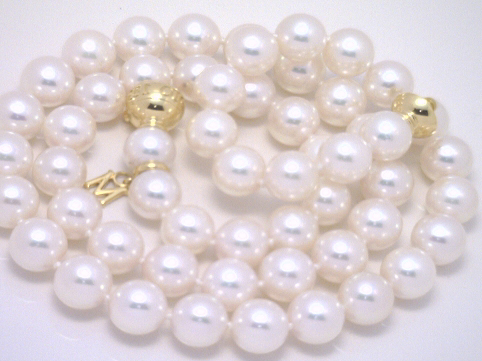Japanese Akoya (saltwater) cultured and natural pearls are similar in that both have a nacreous coating formed around an irritant. In the case of a cultured pearl the irritant is typically a mother of pearl bead only slightly smaller than the cultured pearl.

Freshwater cultured pearls are tissue-nucleated and subsequently are not as spherical as the Akoya cultured pearls.
There are six criterion that are used in grading pearls:
Luster
A high luster pearl will show strong and sharp light reflections. A low luster pearl will look milky or chalky and resemble a mother of pearl bead. Luster is graded on a scale of very high to very low.
Color
Fresh water pearls appear in a variety of colors. This is one of their many attraction. Salt water pearls typically appear in the colors pink, cream, white, yellow, gold, gray, blue and black. Pearls can also have an overtone color. The overtone is often rose, green, blue, or silver. Color is purely subjective. In the United States most people prefer a white or pink color.
Shape
Fresh water pearls appear in a variety of shapes. Salt water pearls are valued higher the closer the pearl approaches in shape a perfectly round sphere. Terms typically used to describe shape are; round, out of round, slightly baroque and baroque.
Size
There is a direct relationship between size and price. The larger the pearl, of the same quality, the greater the value. The most popular size of salt water pearl in the U.S. is 6mm-7mm, followed closely by the 5mm-6mm, and the 7mm.-8mm.
Blemishes
Blemishes are the surface imperfections found on pearls. Like most things created by nature they are rarely perfect. Blemishes can appear as pits, ridges, dimples, dull spots or areas of different color. The fewer blemishes the greater the value.
Matching
Matching refers to the degree the pearls blend with each other. Pearls in a necklace should be similar in appearance to one another in terms of size, color, shape, luster and blemishes. The degree to which the pearls match is graded on a scale from excellent to poor.
Here are some thoughts on the subject offered by the American Gem Society.

There is parking available directly behind our building.
Please take the opportunity to view our e-commerce site. The site can be viewed on your mobile device as well.
Shop Now
Pearls are unique gems that do not originate from the earth. Instead, they form inside mollusks like clams, oysters, and mussels in both freshwater and saltwater environments. When a small foreign object like a grain of sand or parasite enters the mollusk, layers of pearly material develop around it as a natural defense mechanism. In a natural pearl (not cultured), the layers form concentric circles like those of an onion. The overlapping layers reflect light and produce an iridescent luster. As pearls age, their layers become more numerous, resulting in larger pearl sizes. In cultured pearls, the irritant is inserted in the mollusk. The size of the pearl is largely determined by the size of the bead or tissue inserted in the mollusk.
Tues-Fri 11:00 AM - 6:00 PM
Sat 11:00 AM - 5:00 PM
5121 Center Street, Suite 103
Williamsburg, VA 23188
(757) 229-7333